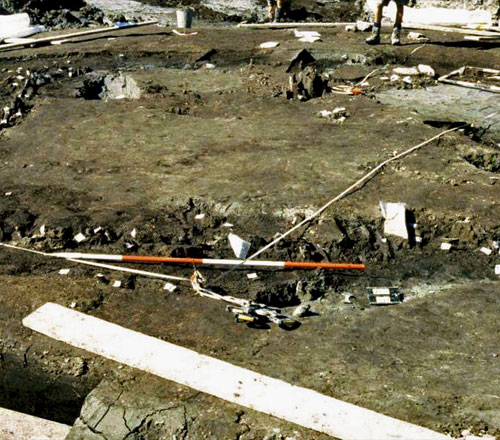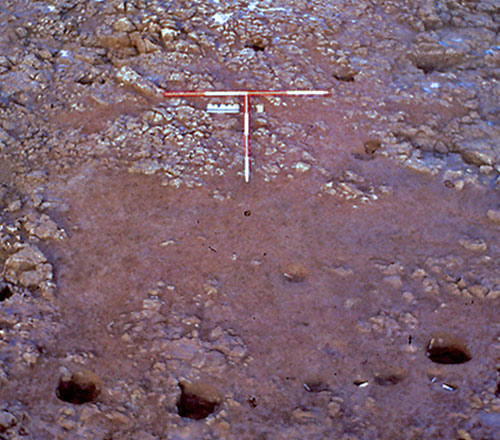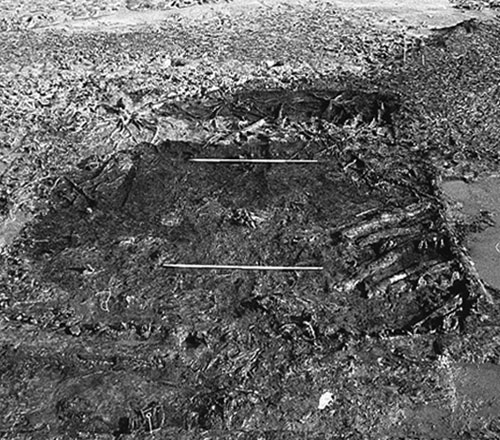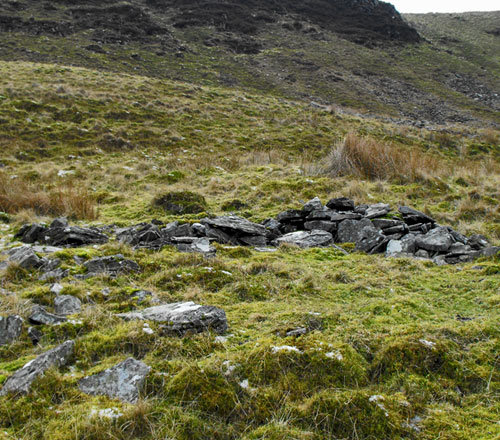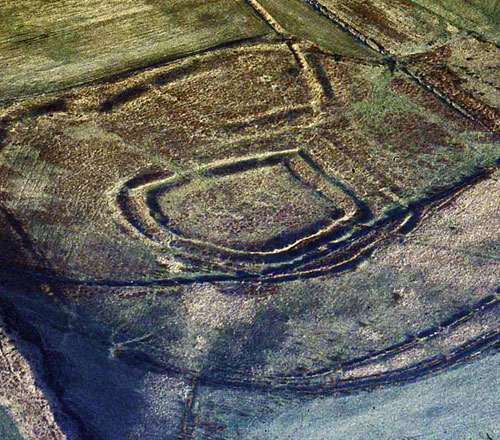Hearth and home
Very little evidence has been found so far in South Wales for where people lived throughout most of prehistory. These early hunter-gatherers would have been nomadic, setting up seasonal camps at places where they came to hunt, fish, or gather other resources. Early peoples are mostly thought of as living in caves, but although traces of prehistoric human activity are found in caves on the Gower peninsula, there is no evidence that people actually lived in them – no hearths and none of the collections of debris we would expect to accumulate where people were staying for any length of time.
Hearths appear at some Mesolithic sites in the Glamorgan uplands, associated with scatters of flint. If the people camping at these spots were living in light huts like benders, they have not left any traces on the ground. The introduction of agriculture in the Neolithic created a step change, as people now had to stay in one place long enough to undertake all the work needed to grow and harvest their crops, and also needed places to store the food they had produced. However, very few Neolithic houses have been discovered so far. Part of one or more Early Neolithic houses were discovered at Cefn Glas, Blaenrhondda during work on a forestry firebreak. Although the firebreak had removed part of the structure, enough remained to show that there were least two hearths and some post-holes, but it wasn’t clear whether it was one trapezoidal house, or two houses, one of which replaced the other in a slightly different position. A group of stakeholes found under a Bronze Age cairn on Cefn Cilsanws on the southern edge of the Brecon Beacons may have been the remains of a Late Neolithic house or hut, but the remains were not clear enough to be certain.
Bronze Age houses are also notable by their absence in much of our area, although there must have been people living here since we have good evidence for where they were buried. In the lowlands, the only houses known were found when burial mounds were excavated and found to have been built over the top. Only in the uplands are still to be seen a number of settlements, consisting clusters of houses/huts or enclosures marked by low curvilinear walls of stone. Although hardly any of these have been excavated, and the ones that have produced little or nothing in the way of dating evidence, they are usually considered to be late prehistoric by analogy with better-studied examples from elsewhere in Britain.
It is only when hillforts and other defended enclosures start to appear on lower ground in the Late Bronze Age that we can be sure where most of the settlements were. So far, we do not have any hillforts in our area that can definitely be dated to the Bronze Age, as only a small proportion of these sites have been excavated. However, they are well established in the Iron Age; most of them are readily identified by their defences. Where they have been excavated, at least some evidence for huts or houses has been noted, although some archaeologists think they may have functioned less as permanent residence than places of refuge when needed. If this was the case, the majority of people will have lived in open settlements which are difficult to find because their houses were made of biodegradable materials which do not usually leave traces above ground once they have fallen into ruin or have been destroyed. Those that have been excavated have usually been found because they were provided with defences later, such as at Biglis, Barry, which started off as a series of timber roundhouses, marked only by post-holes.
Themes
Hearth and home Very little evidence has been found so far in South Wales for where people lived throughout most of prehistory. Learn More
Every path tells a tale Prehistoric people, much like varying cultural groups all over the world today, understood the world in different ways. Spirituality and the inanimate world were intertwined in their daily life. Learn More
Down in the Flood Around the coast of South Wales a whole series of prehistoric landscape drowned by rising sea levels are now only visible at low tide. Learn More
The importance of things Throughout prehistory, artefacts and the technology that created them, have figured prominently in explanations of culture process and culture change. Learn more
About the project
Since the 1980s, we have received grant aid from Cadw to carry out a series of projects looking at the prehistoric archaeology of Glamorgan and Gwent. Some of them were survey projects, looking at the information available on a wide range of different monument types as part of a pan-Wales study aimed at improving protection. Others were locally focussed, and took place in response to a specific threat to a site or group of sites. Before new Planning Guidance was published 1990 (PPG16), these excavations included sites that were under threat from development, but if such project are carried out today, it would be the developer who would be liable for the costs. Cadw still grant-aids rescue excavation of sites that are being destroyed by natural processes, such as coastal erosion.
Please see here to find out more about us, our activities and our forward strategy
